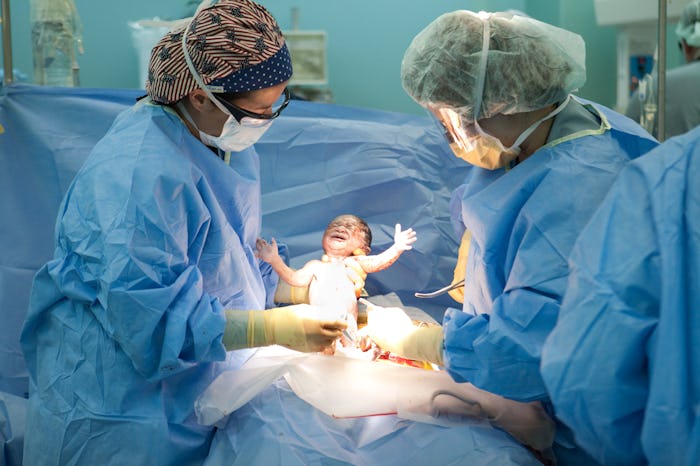Life

More Women Are Requesting "Gentle" C-Sections
There are few moments in a mother's life more powerful, more life-affirming, than the first time they see their child. For some mothers, that happens the instant their child enters the world, but for others, the experience is often delayed due to surgery. Mothers who undergo cesarean sections have traditionally been separated from the birth of their child, sanitized from the reality of birth by a curtain. And so they had to meet their child for the first time via a hastily-taken snapshot. Thankfully, this no longer needs to be the case. More women are asking for "gentle" c-sections, and some experts believe this new process might help mothers connect with their babies in a more immediate fashion.
A c-section is generally unplanned, and can happen when complications arise during birth that could jeopardize the well-being of the mother or baby. According to the Centers for Disease Control and Prevention, around 32 percent of all births in the United States are C-sections, when the mother's womb and abdomen are cut open by a doctor and the baby is removed from the uterus rather than moving through the birth canal. The American College of Obstetricians and Gynecologists (ACOG) has gone on record to say that a vaginal birth is preferable to a c-section, linking vaginal births to a happier birth experience, more satisfying mother-baby bond (due to the skin-on-skin contact) and even a higher breastfeeding success rate. So how do doctors reconcile the mother's need to feel more a part of her birth plan in times of potential distress?
Several doctors have been working towards making the experience better for mothers and babies, not just in the delivery room but down the road as well.
In 2008, Dr. Felicity Plaat, a consultant anesthetist at Imperial College Healthcare NHS Trust in London, sought to reinvent the surgical process of the C-section with her colleagues. Plaat told CNN:
We said, "Could we import these aspects of vaginal birth into the operating theater? And would they be safe, and would they have the same advantages?" That's what started it.
They decided to incorporate lowered lighting, music, and the curtain is lowered so both parents can witness the birth of their child. Babies are given the opportunity to deliver themselves through the incision, much like a vaginal delivery, and the mother's hands aren't strapped down. The results were released at a Euroanaesthesia congress in Geneva this year, and so far the response has been overwhelmingly positive.
While research is still ongoing, the results so far are positive; Babies have been delivered safely, mothers have reported a far more positive birth experience, and breastfeeding rates have improved. As Dr. Plaat told The Bump:
I believe natural c-sections make the experience of birth much more satisfying for the increasing number of women who require c-sections. Denying women this in order to discourage them from considering this mode of delivery is in my personal opinion, completely unethical.
Since 2008, some doctors have begun to perform these "gentle" cesarean sections in the United States, and word is spreading among satisfied mothers who preferred this new, more natural approach. Shannon Schoenfield of Phoenix, Arizona has had two children by cesarean section, one traditional and one natural. Not only did she tell CNN that she was "grateful to have been able to experience" the natural C-section, she also felt it gave her the confidence to breastfeed her baby because she was given the option to nurse while she was still on the operating table:
Personally, I was concerned about breast feeding cause I am older. Though I have two other children, they're 10 and 8, so it's been awhile. It's a relief to have that immediate connection.
As more and more doctors perform gentle c-sections, mothers will be afforded options that make sense to them. Even in the case of a potential emergency.